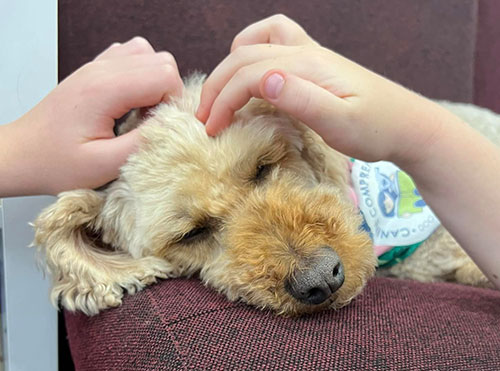
Our Blog
Unleash Peace: Mindfulness with Your Family Dog

We want to share a guided mindfulness exercise incorporating a family dog's calming presence. This practice helps family members improve their emotional regulation and reduce stress. Designed to be both calming and engaging, this exercise provides a wonderful opportunity for family members to connect and their furry friends, fostering a peaceful and harmonious atmosphere for everyone involved.
Introduction to the Mindfulness Exercise
As a Canine Comprehension mentor with expertise in creating therapeutic activities, I've developed this mindfulness exercise to combine the calming effects of mindfulness practices with the emotional support provided by therapy dogs. This exercise is tailored for parents and guardians with a family dog who may be living with young people experiencing stress, anxiety, or difficulties with emotional regulation.
The goal is to create a soothing, non-threatening atmosphere where young people can practice mindfulness while benefiting from the presence of a family dog.
Step-by-Step Guide
1. Setting the Scene (2 minutes):
- Sit comfortably in a semi-circle.
- The dog should be in the centre or moving calmly around those sitting down.
- Remind those involved in the activity that this is a time for relaxation and connecting with themselves and their dog.
2. Breathing Focus (3 minutes):
- Guide the group to close their eyes or soften their gaze.
- Instruct them to take slow, deep breaths, focusing on the sensation of breathing.
- Encourage them to let go of any thoughts or worries, returning focus to their breath if their mind wanders.
3. Body Scan (5 minutes):
- Guide the group through a gentle body scan, starting from their toes and moving up to their head.
- Ask them to notice any sensations in each body part without judgment.
- Remind them to keep breathing deeply and slowly.
4. Dog Awareness (5 minutes):
- Invite the group to open their eyes and observe their dog.
- Guide them to notice the dog's breathing and how its chest rises and falls.
- Encourage them to synchronise their breathing with the dog's, if possible, for only a few breaths.
5. Gentle Interaction (5 minutes):
- If appropriate and safe, allow the group to pet the dog gently.
- Guide them to focus on the sensation of the dog's fur, its warmth, and the rhythm of its breathing.
- Remind them to stay present, noticing any emotions or thoughts that arise.
6. Reflection and Closure (5 minutes):
- Ask the group to slowly withdraw their attention from the dog and return to their own breath.
- Guide them to take a few deep breaths and notice how they feel now compared to the beginning of the exercise.
- Invite them to share any observations or feelings if they wish.
The presence of a family dog in this exercise serves multiple purposes:
1. Emotional Support: The dog provides a comforting presence, helping to reduce anxiety and stress in students.
2. Focus Aid: Observing a living, breathing creature helps you stay present and engaged in the mindfulness practice.
3. Sensory Experience: The tactile sensation of patting the dog (when appropriate) adds a grounding element to the practice.
4. Social Facilitation: The shared experience of interacting with the dog can help build connections with the group.
Benefits:
- Improved emotional regulation
- Reduced stress and anxiety
- Enhanced focus and attention
- Increased empathy and social connection
- Positive association with mindfulness practices
Considerations:
- Ensure all family members are comfortable with the dog.
- Be mindful of the group members who may have had negative experiences with dogs.
- Maintain a calm environment to keep everyone, including the dog, relaxed.
This mindfulness exercise incorporating family dogs offers a unique and effective way to support young people's emotional well-being. Combining mindfulness's proven benefits with the comforting presence of a family dog creates a powerful tool for emotional regulation and stress relief. Enjoy!
*Please note: This exercise with the family dog is a beautiful way to explore mindfulness practice with other family members. However, it's important to note that not all family dog personalities and energy levels are suited to mindfulness exercises. While some dogs naturally have a calm demeanour and can sit quietly during these sessions, others may be more energetic or easily distracted, which might need to align better with the tranquil atmosphere needed for mindfulness. It's essential to consider your dog's individual temperament and energy level when incorporating them into mindfulness activities.
